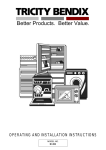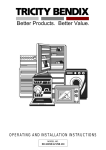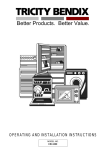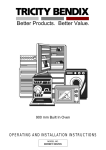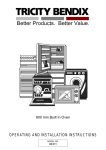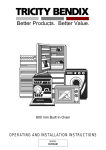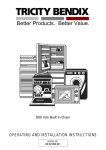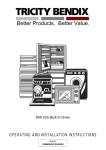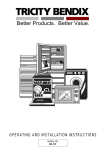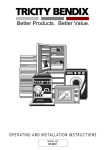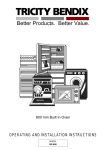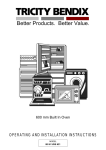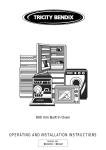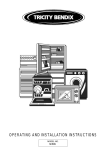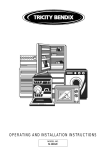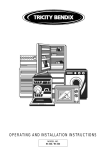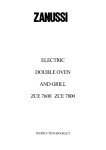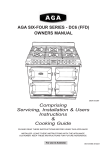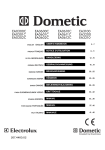Download Tricity Bendix CSI 2500 User's Manual
Transcript
Better Products. Better Value. OPERATING AND INSTALLATION INSTRUCTIONS MODEL NO. CSI 2500 35 TECHNICAL DETAILS MODEL NO. CSI 2500 Voltage: 230/240 Volts AC 50Hz Wattage: 10.0/10.9 kW Height: 900mm Width: 600mm Depth: 598mm This appliance complies with European Council Directive 72/23/EEC. This appliance carries the C.E. mark. 2 CONTENTS Technical Details . . . . . . . . . . . . . . . . . . . . . . . . . . . . . . . . . . . . . . . . . . . . . . . . . . . . . . . . . . . . . . . . . . . . . . . . . . . . . . . . . 2 Contents . . . . . . . . . . . . . . . . . . . . . . . . . . . . . . . . . . . . . . . . . . . . . . . . . . . . . . . . . . . . . . . . . . . . . . . . . . . . . . . . . . . . . . . . . 3 Preface . . . . . . . . . . . . . . . . . . . . . . . . . . . . . . . . . . . . . . . . . . . . . . . . . . . . . . . . . . . . . . . . . . . . . . . . . . . . . . . . . . . . . . . . . . . 5 Safety . . . . . . . . . . . . . . . . . . . . . . . . . . . . . . . . . . . . . . . . . . . . . . . . . . . . . . . . . . . . . . . . . . . . . . . . . . . . . . . . . . . . . . . . . . . . . Before Installation . . . . . . . . . . . . . . . . . . . . . . . . . . . . . . . . . . . . . . . . . . . . . . . . . . . . . . . . . . . . . . . . . . . . . . . . . . . During Operation . . . . . . . . . . . . . . . . . . . . . . . . . . . . . . . . . . . . . . . . . . . . . . . . . . . . . . . . . . . . . . . . . . . . . . . . . . . After Use . . . . . . . . . . . . . . . . . . . . . . . . . . . . . . . . . . . . . . . . . . . . . . . . . . . . . . . . . . . . . . . . . . . . . . . . . . . . . . . . . . . General . . . . . . . . . . . . . . . . . . . . . . . . . . . . . . . . . . . . . . . . . . . . . . . . . . . . . . . . . . . . . . . . . . . . . . . . . . . . . . . . . . . . 6 6 6 7 7 Introduction . . . . . . . . . . . . . . . . . . . . . . . . . . . . . . . . . . . . . . . . . . . . . . . . . . . . . . . . . . . . . . . . . . . . . . . . . . . . . . . . . . . . . . 8 Rating Plate . . . . . . . . . . . . . . . . . . . . . . . . . . . . . . . . . . . . . . . . . . . . . . . . . . . . . . . . . . . . . . . . . . . . . . . . . . . . . . . . 8 Installation . . . . . . . . . . . . . . . . . . . . . . . . . . . . . . . . . . . . . . . . . . . . . . . . . . . . . . . . . . . . . . . . . . . . . . . . . . . . . . . . . . 8 Reversible Main Oven Door . . . . . . . . . . . . . . . . . . . . . . . . . . . . . . . . . . . . . . . . . . . . . . . . . . . . . . . . . . . . . . . . . 9 General Notes on Using Your Cooker . . . . . . . . . . . . . . . . . . . . . . . . . . . . . . . . . . . . . . . . . . . . . . . . . . . . . . . . 9 About Condensation and Steam . . . . . . . . . . . . . . . . . . . . . . . . . . . . . . . . . . . . . . . . . . . . . . . . . . . . . . . . . . . . . 9 The Cooling Fan for the Controls . . . . . . . . . . . . . . . . . . . . . . . . . . . . . . . . . . . . . . . . . . . . . . . . . . . . . . . . . . . . 9 Control Panel Indicator Neons . . . . . . . . . . . . . . . . . . . . . . . . . . . . . . . . . . . . . . . . . . . . . . . . . . . . . . . . . . . . . . . 9 Cookware . . . . . . . . . . . . . . . . . . . . . . . . . . . . . . . . . . . . . . . . . . . . . . . . . . . . . . . . . . . . . . . . . . . . . . . . . . . . . . . . . . 9 Grill and Oven Furniture . . . . . . . . . . . . . . . . . . . . . . . . . . . . . . . . . . . . . . . . . . . . . . . . . . . . . . . . . . . . . . . . . . . . 10 Getting to Know your Cooker . . . . . . . . . . . . . . . . . . . . . . . . . . . . . . . . . . . . . . . . . . . . . . . . . . . . . . . . . . . . . . . . . . . 11 The Control Panel . . . . . . . . . . . . . . . . . . . . . . . . . . . . . . . . . . . . . . . . . . . . . . . . . . . . . . . . . . . . . . . . . . . . . . . . . 11 The Timer . . . . . . . . . . . . . . . . . . . . . . . . . . . . . . . . . . . . . . . . . . . . . . . . . . . . . . . . . . . . . . . . . . . . . . . . . . . . . . . . . 12 The Ceramic Hob . . . . . . . . . . . . . . . . . . . . . . . . . . . . . . . . . . . . . . . . . . . . . . . . . . . . . . . . . . . . . . . . . . . . . . . . . . . . . . . Recommended Saucepans . . . . . . . . . . . . . . . . . . . . . . . . . . . . . . . . . . . . . . . . . . . . . . . . . . . . . . . . . . . . . . . . . Hints and Tips . . . . . . . . . . . . . . . . . . . . . . . . . . . . . . . . . . . . . . . . . . . . . . . . . . . . . . . . . . . . . . . . . . . . . . . . . . . . . Hot Hob Indicator . . . . . . . . . . . . . . . . . . . . . . . . . . . . . . . . . . . . . . . . . . . . . . . . . . . . . . . . . . . . . . . . . . . . . . . . . . Deep Fat Frying . . . . . . . . . . . . . . . . . . . . . . . . . . . . . . . . . . . . . . . . . . . . . . . . . . . . . . . . . . . . . . . . . . . . . . . . . . . Preserving . . . . . . . . . . . . . . . . . . . . . . . . . . . . . . . . . . . . . . . . . . . . . . . . . . . . . . . . . . . . . . . . . . . . . . . . . . . . . . . . . 16 16 16 17 17 17 The Grill . . . . . . . . . . . . . . . . . . . . . . . . . . . . . . . . . . . . . . . . . . . . . . . . . . . . . . . . . . . . . . . . . . . . . . . . . . . . . . . . . . . . . . . . Uses of the Dual Grill . . . . . . . . . . . . . . . . . . . . . . . . . . . . . . . . . . . . . . . . . . . . . . . . . . . . . . . . . . . . . . . . . . . . . . Selecting the Grill . . . . . . . . . . . . . . . . . . . . . . . . . . . . . . . . . . . . . . . . . . . . . . . . . . . . . . . . . . . . . . . . . . . . . . . . . . Things to Note . . . . . . . . . . . . . . . . . . . . . . . . . . . . . . . . . . . . . . . . . . . . . . . . . . . . . . . . . . . . . . . . . . . . . . . . . . . . . The Grill Pan and Handle . . . . . . . . . . . . . . . . . . . . . . . . . . . . . . . . . . . . . . . . . . . . . . . . . . . . . . . . . . . . . . . . . . . Hints and Tips . . . . . . . . . . . . . . . . . . . . . . . . . . . . . . . . . . . . . . . . . . . . . . . . . . . . . . . . . . . . . . . . . . . . . . . . . . . . . Grilling Chart . . . . . . . . . . . . . . . . . . . . . . . . . . . . . . . . . . . . . . . . . . . . . . . . . . . . . . . . . . . . . . . . . . . . . . . . . . . . . . 18 18 18 18 18 19 19 The Top Oven . . . . . . . . . . . . . . . . . . . . . . . . . . . . . . . . . . . . . . . . . . . . . . . . . . . . . . . . . . . . . . . . . . . . . . . . . . . . . . . . . . . Uses of the Top Oven . . . . . . . . . . . . . . . . . . . . . . . . . . . . . . . . . . . . . . . . . . . . . . . . . . . . . . . . . . . . . . . . . . . . . . Selecting the Top Oven . . . . . . . . . . . . . . . . . . . . . . . . . . . . . . . . . . . . . . . . . . . . . . . . . . . . . . . . . . . . . . . . . . . . Things to Note . . . . . . . . . . . . . . . . . . . . . . . . . . . . . . . . . . . . . . . . . . . . . . . . . . . . . . . . . . . . . . . . . . . . . . . . . . . . . To Fit the Top Oven Shelf . . . . . . . . . . . . . . . . . . . . . . . . . . . . . . . . . . . . . . . . . . . . . . . . . . . . . . . . . . . . . . . . . . Hints and Tips . . . . . . . . . . . . . . . . . . . . . . . . . . . . . . . . . . . . . . . . . . . . . . . . . . . . . . . . . . . . . . . . . . . . . . . . . . . . . 20 20 20 20 20 21 The Main Fan Oven . . . . . . . . . . . . . . . . . . . . . . . . . . . . . . . . . . . . . . . . . . . . . . . . . . . . . . . . . . . . . . . . . . . . . . . . . . . . . . Uses of the Fan Oven . . . . . . . . . . . . . . . . . . . . . . . . . . . . . . . . . . . . . . . . . . . . . . . . . . . . . . . . . . . . . . . . . . . . . . Selecting the Fan Oven . . . . . . . . . . . . . . . . . . . . . . . . . . . . . . . . . . . . . . . . . . . . . . . . . . . . . . . . . . . . . . . . . . . . Things to Note . . . . . . . . . . . . . . . . . . . . . . . . . . . . . . . . . . . . . . . . . . . . . . . . . . . . . . . . . . . . . . . . . . . . . . . . . . . . . To Fit the Main Oven Shelves . . . . . . . . . . . . . . . . . . . . . . . . . . . . . . . . . . . . . . . . . . . . . . . . . . . . . . . . . . . . . . Hints and Tips . . . . . . . . . . . . . . . . . . . . . . . . . . . . . . . . . . . . . . . . . . . . . . . . . . . . . . . . . . . . . . . . . . . . . . . . . . . . . 22 22 22 22 22 23 Oven Cooking Chart . . . . . . . . . . . . . . . . . . . . . . . . . . . . . . . . . . . . . . . . . . . . . . . . . . . . . . . . . . . . . . . . . . . . . . . . . . . . . 24 Roasting Chart . . . . . . . . . . . . . . . . . . . . . . . . . . . . . . . . . . . . . . . . . . . . . . . . . . . . . . . . . . . . . . . . . . . . . . . . . . . . . . . . . . 25 3 CONTENTS 4 Defrosting . . . . . . . . . . . . . . . . . . . . . . . . . . . . . . . . . . . . . . . . . . . . . . . . . . . . . . . . . . . . . . . . . . . . . . . . . . . . . . . . . . . . . . . Uses of Defrost Feature . . . . . . . . . . . . . . . . . . . . . . . . . . . . . . . . . . . . . . . . . . . . . . . . . . . . . . . . . . . . . . . . . . . Selecting Defrost . . . . . . . . . . . . . . . . . . . . . . . . . . . . . . . . . . . . . . . . . . . . . . . . . . . . . . . . . . . . . . . . . . . . . . . . . Things to Note . . . . . . . . . . . . . . . . . . . . . . . . . . . . . . . . . . . . . . . . . . . . . . . . . . . . . . . . . . . . . . . . . . . . . . . . . . . . Hints and Tips . . . . . . . . . . . . . . . . . . . . . . . . . . . . . . . . . . . . . . . . . . . . . . . . . . . . . . . . . . . . . . . . . . . . . . . . . . . . 26 26 26 26 26 Care and Cleaning . . . . . . . . . . . . . . . . . . . . . . . . . . . . . . . . . . . . . . . . . . . . . . . . . . . . . . . . . . . . . . . . . . . . . . . . . . . . . . . Cleaning Materials . . . . . . . . . . . . . . . . . . . . . . . . . . . . . . . . . . . . . . . . . . . . . . . . . . . . . . . . . . . . . . . . . . . . . . . . Cleaning the Ceramic Hob . . . . . . . . . . . . . . . . . . . . . . . . . . . . . . . . . . . . . . . . . . . . . . . . . . . . . . . . . . . . . . . . . Hints and Tips . . . . . . . . . . . . . . . . . . . . . . . . . . . . . . . . . . . . . . . . . . . . . . . . . . . . . . . . . . . . . . . . . . . . . . . . . . . . Cleaning the Outside of the Cooker . . . . . . . . . . . . . . . . . . . . . . . . . . . . . . . . . . . . . . . . . . . . . . . . . . . . . . . . Cleaning the Grill Deflector, Meat Tin, Grill Pan, Grill Pan Grid and Oven Shelves . . . . . . . . . . . . Cleaning Inside the Oven and Grill Compartments . . . . . . . . . . . . . . . . . . . . . . . . . . . . . . . . . . . . . . . . . . Care of Stayclean Surfaces . . . . . . . . . . . . . . . . . . . . . . . . . . . . . . . . . . . . . . . . . . . . . . . . . . . . . . . . . . . . . . . . Hints and Tips . . . . . . . . . . . . . . . . . . . . . . . . . . . . . . . . . . . . . . . . . . . . . . . . . . . . . . . . . . . . . . . . . . . . . . . . . . . . Cleaning between the Outer and Inner Door Glass . . . . . . . . . . . . . . . . . . . . . . . . . . . . . . . . . . . . . . . . . . Replacing the Oven Light Bulb . . . . . . . . . . . . . . . . . . . . . . . . . . . . . . . . . . . . . . . . . . . . . . . . . . . . . . . . . . . . . 27 27 27 28 28 28 28 29 29 29 30 Something Not Working? . . . . . . . . . . . . . . . . . . . . . . . . . . . . . . . . . . . . . . . . . . . . . . . . . . . . . . . . . . . . . . . . . . . . . . . Service and Spare Parts . . . . . . . . . . . . . . . . . . . . . . . . . . . . . . . . . . . . . . . . . . . . . . . . . . . . . . . . . . . . . . . . . . . . . . . . . Customer Service Centres . . . . . . . . . . . . . . . . . . . . . . . . . . . . . . . . . . . . . . . . . . . . . . . . . . . . . . . . . . . . . . . . . . . . . . . Guarantee Conditions . . . . . . . . . . . . . . . . . . . . . . . . . . . . . . . . . . . . . . . . . . . . . . . . . . . . . . . . . . . . . . . . . . . . . . . . . . . 31 32 33 37 PREFACE Dear Customer, Thank you for buying a Tricity Bendix cooker. With our 80 years experience in developing and manufacturing the very best in U.K. cookers, you can be assured that you have purchased a hard working, reliable, quality product. Tricity Bendix cookers comply with British Standard safety and performance requirements. They have been approved by BEAB (British Electrotechnical Approvals Board) and are covered by a 12 month parts and labour guarantee. To get the best from your new Tricity Bendix cooker, we ask that you PLEASE READ THESE INSTRUCTIONS CAREFULLY. Particular attention should be made to cooking times and temperatures which may differ from your previous cooker. It is most important that this instruction book is retained with the cooker for future reference. Should the cooker be sold, or if you move house and leave the cooker, always ensure that the book remains with the cooker. This will enable the new owner to be acquainted with the functioning of the cooker and the relevant warnings. Please read the whole instruction book before attempting to use the cooker ensuring you follow the recommendations given. 5 SAFETY THESE WARNINGS ARE PROVIDED IN THE INTERESTS OF YOUR SAFETY. ENSURE THAT YOU UNDERSTAND THEM ALL BEFORE INSTALLING OR USING THE COOKER. PLEASE READ CAREFULLY DURING OPERATION Do not use this cooker if it is in contact with water. Never operate it with wet hands. This cooker is designed to be operated by adults and children under supervision. Young children must not be allowed to tamper with the cooker or play with the controls. BEFORE INSTALLATION This cooker is heavy and care must be taken when moving it. Ensure that all packaging, both inside and outside the cooker has been removed before the appliance is used. Do not try to move the cooker by pulling the door handles. The electrical installation work must be undertaken by a qualified electrician / competent person. It is dangerous to alter or modify the specifications of the cooker in any way. Do not use the cooker if the ceramic glass is damaged. If a fault or crack becomes visible during cooking, disconnect the cooker immediately from the electricity supply and contact the Customer Service Centre. After installation, please dispose of the packaging with due regard to safety and the environment. 6 Accessible parts especially around the grill area may become hot when the cooker is in use. Children should be kept away until it has cooled. Take great care when heating fats and oils as they will ignite if they become too hot. This cooker has been designed for cooking edible foodstuffs only, and must not be used for any other purposes. Never place plastic or any other material which may melt in the oven or on the hob. Ensure cooking utensils are large enough to contain foods to prevent spillages and boil overs. The handles of saucepans which are smaller than the heated area on the hob will become hot. Ensure your hand is protected before handling the pan. Take care to follow the recommendations given for tending the food when grilling. Do not leave the grill pan handle in position when grilling as it will become hot. Always use oven gloves to remove and replace the grill pan handle when grilling. Recommendations given on page 18. Ensure that you support the grill pan when it is in the withdrawn or partially withdrawn position. Cookers and hobs become very hot, and retain their heat for a long period of time after use. Children should be kept well away from the cooker until it has cooled. GENERAL Ensure that all vents are left unobstructed to ensure ventilation of the oven. Under no circumstances should repairs be carried out by inexperienced persons as this may cause injury or serious malfunction. This cooker should be serviced by an authorised Service Engineer and only genuine approved spare parts should be used. Ensure that the anti-tilt shelves are put in place correctly. Refer to instructions on pages 20 and 22. Do not stand on the cooker or on the open oven door. Never line any part of the cooker with aluminium foil. Always stand back from the cooker when opening the oven door to allow any build up of steam or heat to release. Do not place sealed cans or aerosols inside the oven. They may explode if they are heated. Do not leave the hotplates switched ON for long periods when not covered by a saucepan. The controls may overheat. Do not hang towels, dishcloths or clothes from the cooker or its handle. They are a safety hazard. Always allow the cooling fan to cool the cooker down before switching off at the wall prior to carrying out any cleaning or maintenance work. Only clean this cooker in accordance with the instructions given in this book. AFTER USE Ensure that all control knobs are in the OFF position when not in use. Your safety is of paramount importance. For hygiene and safety reasons this cooker should be kept clean at all times. A build-up of fats or other foodstuffs could result in a fire, especially in the grill pan. Therefore, if you are unsure about any of the meanings of these WARNINGS contact the: Consumer Care Department Telephone (01582) 585858 Do not leave utensils containing foodstuffs, e.g. fat or oil in or on the cooker in case it is inadvertently switched ON. 7 INTRODUCTION WARNING: THIS COOKER MUST BE EARTHED RATING PLATE The cable should be routed away from potentially hot areas marked by X in the diagram below. Record the model and serial numbers on the back cover from the rating plate. This is situated on the lower front frame of the cooker and can be seen upon opening the fan oven door. The cooker must be protected by a suitably rated fuse or circuit breaker. The rating of the cooker is given on the rating plate. REAR VIEW To move the cooker, open the fan oven door, and lift the cooker by holding inside the top of the compartment. INSTALLATION This cooker complies with Radio Interference requirements of EEC Directive 87/308/EEC. If your cooker has been damaged in transit, contact your supplier immediately. DO NOT attempt to install it. Your cooker left the factory fully packaged to protect it from damage. If it is delivered without packaging and damage has occurred the manufacturer cannot accept responsibility. Contact your supplier for advice. Once the packaging has been removed the cooker should only be moved by hand. DO NOT use a sack barrow or any other aid to lift the cooker as damage may occur. Connection to the electricity supply must be carried out by a qualified electrician/competent person. The electrical connection should be made using a double pole isolating switch (cooker socket) with at least 3mm contact separation. The cable must have conductors of sufficiently high cross-sectional area to prevent overheating and deterioration. The recommended cross-section area is six square millimetres (6.00mm²). 8 This is a type Y cooker which means it is free-standing and can be fitted with cabinets on one or both sides. It may also be fitted in a corner setting. Ensure that the cooker is standing level. Side walls which are above hob level should be protected by heat resistant non-combustible material and MUST NOT be nearer than 40mm to the hob side. A nominal air gap of 2mm all around the cooker is required to enable the cooker to be moved into position. A spacer has been incorporated into the back of the appliance to ensure an air gap of 10mm is maintained at hotplate level. Tiles or other forms of deep wall covering should not obscure this gap. Note: Vapours from the oven vents may in time cause discoloration of wallcoverings behind the cooker. For ease of cleaning it may be preferable to tile behind the cooker. Overhanging surfaces or a cooker hood should be a minimum of 685mm above the hob. For your safety wallcoverings at the rear of the cooker should be securely fixed to the wall. THE COOLING FAN FOR THE CONTROLS The cooling fan operates immediately when the grill or top oven is switched on. It may run on after the controls are switched off until the appliance has cooled. If an automatic programme has been set the cooling fan does not switch on until the cooktime begins. Note: The action of the cooling fan will depend on how long the top oven or grill have been used and at what temperature. It may not run on where the grill or top oven has been used for a short time or at low temperatures. CONTROL PANEL INDICATOR NEONS It is important to ensure that the cooker is level after installation. Levelling feet are fitted to the front of the cooker to accommodate uneven floors. REVERSIBLE MAIN OVEN DOOR These lights indicate whether the ovens are switched on. The neons also indicate when the set temperature has been reached. They will cycle on and off during use to show that the temperature is being maintained. If you require the oven door to be hinged on the opposite side, you will need to contact a qualified Service Engineer. See page 33 for your nearest Service Centre. PLEASE NOTE that a charge will be made. If the neons do not operate as the instructions indicate the controls have been incorrectly set. Return all controls to zero and re-set following the instructions for the required setting. GENERAL NOTES ON USING YOUR COOKER When the oven has been set for automatic cooking the neon will remain unlit until the cooktime begins. We suggest that you run all the elements for a short period to burn off any residue from their surfaces. COOKWARE During this period an unpleasant odour may be emitted, it is therefore advisable to open a window for ventilation. ABOUT CONDENSATION AND STEAM Baking trays, oven dishes etc., should not be placed directly against the grid covering the fan at the back of the oven. Do not use baking trays larger than 30cm x 35cm (12" x 14") as they will restrict the circulation of heat and may affect performance. When food is heated it produces steam similar to a boiling kettle. The ovens are vented to allow some of this steam to escape. However, always stand back from the cooker when opening the oven door to allow any build up of steam or heat to release. If the steam comes into contact with a cool surface on the outside of the cooker, e.g. a trim, it will condense and produce water droplets. This is quite normal and is not caused by a fault on the appliance. To prevent discoloration, regularly wipe away condensation and also soilage from surfaces including the vent at the rear of the hob. See note at the top of this page. 9 GRILL AND OVEN FURNITURE The following items of grill and oven furniture have been supplied with the cooker. 1 grill pan 1 grill pan handle 1 grill pan grid 1 grill deflector 1 meat tin 1 trivet 1 cranked shelf for grilling and top oven cooking only 2 straight shelves for main oven cooking Scuffing of the Stayclean main oven lining by the oven furniture pack may occur during transit. These marks will disappear after the oven elements have been burnt off for the first time. 10 GETTING TO KNOW YOUR COOKER THE CONTROL PANEL - CSI 2500 A B D C F G E FEATURES A B C D E F G - Timer Main Oven Temperature Control Main Oven Indicator Neon Top Oven Temperature Control Top Oven Indicator Neon Dual Grill Control Hotplate Controls 11 THE TIMER KEY A B C D E F G H AUTO DISPLAY MINUTE MINDER BUTTON COOKING HOURS BUTTON STOP TIME BUTTON COOKING SYMBOL MANUAL SELECTOR BUTTON DECREASE CONTROL INCREASE CONTROL NOTE: STEP 1 BELOW MUST BE FOLLOWED BEFORE THE OVEN WILL OPERATE MANUALLY. 1. 1. SET THE TIME OF DAY When the electricity supply is first switched ON, the display will flash both 0.00 and AUTO. See Fig. 1. Press the two buttons marked ( ) and ( ) while holding them down, press the increase control button (+) and if necessary, the decrease control button (-) until the correct time on the 24 hour clock is reached, e.g. 10.00am as Fig. 2. 2. Note: The increase and decrease control buttons operate slowly at first, and then more rapidly. They should be pressed separately. The AUTO symbol will go out and the cooking symbol will light ( ). See Fig 2. 2. THE MINUTE MINDER The minute minder gives an audible reminder at the end of any period of cooking up to 23 hrs 59 mins. It is not part of the automatic control. To set, press the minute minder button ( the digital display will read 0.00 as Fig. 3. 3. ) and While holding it down, press the increase control (+) until the display indicates the interval to be timed, e.g. 1 hr 45 mins as Fig. 4. NOTE: This must be completed within 5 seconds of first pressing the minute minder button. 12 4. Release the minute minder button and the display will return to the time of day after 5 seconds. 5. During the operation of the minute minder the remaining time period can be shown in the display by pressing the minute minder button ( ). See Fig. 5. The minute minder will sound intermittently, for up to 2 minutes at the end of the timed period. The sound can be stopped by pressing any of the buttons. 3. HOW TO SET THE OVEN TIMER CONTROL When using the timer control for the very first time, it is advisable to let it operate while you are at home. The displays can be checked to show that it is operating correctly and you will then feel confident to leave a meal to cook automatically in the future. A) TO SET THE TIMER TO SWITCH ON AND OFF AUTOMATICALLY i) Ensure the electricity supply is switched ON and that the correct time of day is displayed, e.g. 9 a.m. as Fig. 6. ii) Place food in oven. iii) To set the length of Cooking Time, press the cooking hours button (----), while holding it down, press the increase control ( + ) until the cooking time is displayed, e.g. 2 hrs 15 mins. Fig. 7. 6. 7. iv) Release the buttons. The AUTO display and cooking symbols will glow. Remember, this must be completed within 5 seconds of first pressing the cooking hours button. v) Set the STOP time. Press the stop time button ( ) while holding it down, press the increase control ( + ), until the required stop time is displayed. e.g. 12.15p.m. Fig. 8. 8. vi) Release the buttons. The cooking symbol will go out and the time of day will be displayed after 5 seconds. vii) Set the oven control to the required temperature. The oven indicator neon should be OFF and the AUTO display will glow. 13 Note: When the automatic timed period starts, the oven indicator neon will cycle ON and OFF during cooking. 9. B) TO SET THE TIMER TO SWITCH OFF ONLY i) Ensure the electricity supply is switched ON and that the correct time of day is displayed, e.g. 10.00am. Fig.9. ii) Place food in oven. iii) To set the length of Cooking Time press the cooking hours button ( ) while holding it down, press the increase control (+) until the cooking time is displayed, e.g. 2 hrs 15 mins. Fig. 10. 10. iv) Release the buttons. The AUTO display will glow and the time of day will be displayed after 5 seconds. v) Set the oven temperature. The oven indicator neon should be ON. vi) To check the stop time during the cooking period, simply press the stop time button and the stop time ( ) will be displayed. Fig.11. 11. 4. RETURNING THE COOKER TO MANUAL OR TO CANCEL AN AUTOMATIC PROGRAMME. At the end of a timed cooking period, the AUTO light will flash and a bleeper will sound for up to 2 mins. This can be stopped by pressing any of the buttons. Fig. 12. 12. Turn the oven temperature control to the OFF position. The AUTO display will continue to flash. Press ( ) button. The AUTO display will go out and the cooking symbol will light ( ) Fig. 13. Turn the oven control ON to check that the oven operates manually. The oven indicator neon will glow. Turn all oven controls OFF. No indicator neons should be illuminated. 14 13. 5. THINGS TO NOTE * The time of day cannot be altered whilst the AUTO symbol is lit. * A programme may be cancelled by returning the cooking hours to zero. Press the cooking hours button ( ) while holding it down, depress ( - ) button until 0.00 is displayed. (Fig. 14). * Release all buttons. The AUTO display will now flash and acts as a reminder to reset the appliance to manual. 14. 6. AUTOMATIC COOKING It is advisable to leave food in the oven for as short a time as possible before automatic cooking. When cooking is complete do not leave food to stand in the oven, but remove and cool it quickly if the food is not to be consumed immediately. Always ensure food in the oven is covered if its not possible to remove food immediately after cooking. 15 THE CERAMIC HOB CAUTION: DO NOT USE THE COOKER IF THE CERAMIC GLASS IS DAMAGED. IF A FAULT OR CRACK BECOMES VISIBLE DURING COOKING, DISCONNECT THE COOKER IMMEDIATELY FROM THE ELECTRICITY SUPPLY AND CONTACT THE CUSTOMER SERVICE CENTRE. USING THE HOB l l l l To operate the dual hotplate turn the control knob clockwise for the full area, or anticlockwise for the centre section. The inner section is very economical when cooking with small diameter saucepans. For single hotplates, turn the control knob in either direction to vary the heat setting. The highest number represents the hottest setting and the lowest the coolest setting. Choose a setting appropriate to the quantity and type of food to be cooked. This model has the added feature of three Reflex hotplates which react more quickly than other ceramic hotplates and are easily identified by their rapid red glow. NOTE Occasionally the heated areas may be seen to switch ON and OFF when higher heat settings are being used. This is due to a safety device which prevents the glass from overheating. Some switching ON and OFF when cooking at high temperatures, e.g. deep fat frying is quite normal, causes no damage to the hob and little delay in cooking times. Excessive switching may however be caused by the use of an unsuitable saucepan or a saucepan which is smaller than the heated area. If excessive switching occurs, discontinue use of the saucepan. HINTS AND TIPS l RECOMMENDED SAUCEPANS For speed and economy only good quality saucepans with flat bases and close fitting lids are recommended. The saucepan base should be approximately the same size as the cooking area, a base diameter of up to 225mm (9") may be used on a 180mm (7") heated area. l Ensure that new saucepans are well scrubbed to remove edges and take off any deposits left from manufacture. Pressure cookers, preserving pans etc., should comply with the recommendations given above. Traditional round bottomed Woks must not be used even with a stand. Woks with flat-bottomed bases are available and do comply with the above recommendations. 16 l Lift, rather than slide saucepans on and off the heated areas. This will reduce the risk of scratches and metal marks from saucepans with aluminium bases. Metal marks can be easily cleaned off providing they are not allowed to burn on. Follow any guidelines provided by the saucepan manufacturer, particularly those relating to recommended heat settings. Avoid using thin badly dented or distorted saucepans. Those with uneven bases should not be used. l To prolong the life of hotplates:- l Never use utensils with a skirt, e.g. a bucket. l Never use an asbestos mat. l Never leave the hotplates ON when not l l 5. Double frying chips Ensure that hob and saucepans are clean and dry before the start of cooking to reduce cleaning. Double frying will ensure good chips. First fry the chips for a few minutes at 170°C/340°F to seal the outside. Remove the chips from the oil. Increase the temperature of the oil to 190°C/375°F to finish cooking and brown the chips. Follow the cleaning instructions very closely to keep the hob looking like new. Chips may be kept for several hours after the first frying before finishing off with the second frying. covered with a saucepan. l Turn the food if necessary; doughnuts float to the surface so will not brown on the upperside if not turned. Once cooked, drain the food on absorbent paper. If spillage occurs with sugar solutions, e.g. jams and syrups, it must be wiped from the hob before it sets and becomes hard otherwise damage to the hob will occur. HOT HOB INDICATOR The ceramic hob is fitted with a hot hob indicator light which illuminates when the hob is too hot to touch. The light will go OFF when the hob has cooled. DEEP FAT FRYING SPECIAL FRYING NOTE: For safety purposes when deep fat frying, fill the pan one-third full of oil, DO NOT cover the pan with a lid and DO NOT leave the pan unattended. In the unfortunate event of a fire, switch the cooker OFF at the electricity supply and cover the pan with a lid or damp cloth to assist in smothering the flames. DO NOT use water on the fire. Leave the pan to cool for at least 30 minutes before moving it. DO NOT leave the fat or oil in the frying pan on the hob to store it in case the hob is inadvertently switched ON. 1. Preparing the food Seal the food by coating with flour, egg and breadcrumbs or batter. Do not use a basket with batter coated foods as they will stick. 2. Amount of oil For safety purposes fill the pan only one-third full of oil. 3. Testing the temperature of the oil It is advisable to use a thermometer to test the temperature of the oil. Alternatively, drop a small cube of bread into the oil which should brown in just under a minute if the oil is at the correct temperature of 190°C/375°F. 4. Cooking the food Lower the food gently into the oil. Do not add too much food at once or the temperature of the oil will be reduced and may result in soggy, greasy food. 6. Frying temperatures Celsius Fahrenheit Scale (oC) Scale (oF) 150 300 First frying of potatoes 170 175 180 340 350 360 Second frying of potatoes Frying chicken and fish 190 195 200 375 380 390 PRESERVING 1. DO NOT use a pan that overlaps the perimeter of the hob trim. 2. To allow for a full rolling boil, the pan should be no more than one third full when all the ingredients have been added. It is better to use two pans rather than overfill one, or use half quantities. 3. Use firm fruit or vegetables and wash well before using. 4. Preserving sugar gives clear jam, however granulated sugar is cheaper and gives equally good flavour. 5. Crystallization may be caused if sugar is not completely dissolved before bringing jam to the boil. Over boiling will affect the flavour, setting properties and colour of the jam. 6. To test jam for setting: If a jam thermometer is available, boil jam to 104°C. Marmalade should be boiled to 106°C. If a thermometer is not available, remove pan from heat, place sample of jam on a cold dish and cool quickly (i.e. in a freezer or frozen food storage compartment of a refrigerator). When cold, it will crinkle and hold the mark of a finger run through it, if it is at setting point. 7. The scum should be removed as soon as possible from the surface of the preserve after setting point has been reached. Marmalade should be allowed to cool before potting to prevent the peel rising. 17 THE GRILL USES OF THE DUAL GRILL CAUTION - ACCESSIBLE PARTS MAY BECOME HOT WHEN THE GRILL IS IN USE. CHILDREN SHOULD BE KEPT AWAY. The grill is a dual circuit grill which means that the full area of the grill can be used or for economy purposes the centre section only can be used when cooking smaller quantities of food. SELECTING THE GRILL l l To operate the grill turn the grill control clockwise for full area grilling and anti-clockwise for centre section grilling only. The highest number represents the hottest setting and the lowest the coolest setting. THINGS TO NOTE l The cooling fan will operate in conjunction with the grill. For more details on the operation of the cooling fan see page 9. NOTE Ensure the handle is positively located. When removing the handle, press the button on the handle with the thumb and pivot the handle slightly upwards and towards the right to remove from the bracket. Ensure your hand is protected when removing the grill pan handle as the grill element can become very hot. ALWAYS REMOVE THE GRILL PAN HANDLE DURING GRILLING. THE GRILL DOOR MUST BE LEFT OPEN DURING GRILLING. If the grill door is accidentally closed during grilling a safety device incorporated in the cooker will cut out the grill. The top oven cannot be operated when the grill is in use. If the grill and top oven controls are selected at the same time, only the top oven will operate. The outer grill element may appear to glow slightly brighter than the inner element. This is quite normal. THE GRILL PAN AND HANDLE The grill pan is supplied with a removable handle. To insert the handle, press the button on the handle with the thumb and pivot the handle slightly upwards inserting the lip into widest part of the bracket. Move the handle towards the left, lower into position and release the button. 18 To correctly locate the grill pan on the shelf, ensure that the cut out on the underside of the handle bracket locates over the front bar of the shelf. To check the progress of the food being grilled, the grill pan should be withdrawn on the shelf to attend to food during cooking or the carrier shelf can be lifted away from the cooker and rested on a heat resistant work surface. GRILLING CHART FOOD SHELF GRILL TIME (mins in total) Adjust 5-6 shelf 10-15 Chicken Joints position 30-40 Chops - Lamb Pork and 15-20 20-30 Bacon Rashers Beefburgers grill Fish - Whole HINTS AND TIPS l l l Food should be thoroughly dried before grilling to minimise splashing. Brush lean meats and fish lightly with a little oil or melted butter to keep them moist during cooking. Adjust the height of the grilling grid and grill pan runner position to allow for different foods. Accompaniments such as tomatoes and mushrooms may be placed underneath the grid when grilling meats. pan 15-25 grid 10-15 to 20-30 suit 8-12 different 10-20 thicknesses 20-30 of 6-12 12-16 14-20 Trout/Mackerel Fillets - Plaice/Cod Kebabs Kidneys - Lamb/Pig Liver - Lamb/Pig Sausages Steaks - Rare Medium Well Done food 3-4 Toasted Sandwiches The times quoted above are given as a guide and should be adjusted to suit personal taste. l l l l When toasting bread use the cranked shelf in position 2 with the grid in the high position. Preheat the grill on a full setting for a few minutes before sealing steaks or toasting. Adjust the heat setting and the shelf as necessary during cooking. The food should be turned over during cooking as required. When using the centre section of the dual grill, ensure food is positioned centrally on the grill pan grid in the grill pan. 19 THE TOP OVEN USES OF THE TOP OVEN The top oven is the smaller of the two ovens. It is heated by elements in the top and bottom of the oven. It is designed for cooking on one level and for small quantities of food. It gives especially good results if used to cook fruit cakes, sweet or savoury flans or quiche. The top oven is also ideal for use as a warming compartment to warm dishes and keep food hot. Use a temperature setting of 80° - 100°C on the top oven control dial. SELECTING THE TOP OVEN l l Turn the top oven temperature control to the required setting. The cooling fan will operate immediately with the top oven. For more details on cooling fan operation see page 9. THINGS TO NOTE 1. The grill cannot be operated when the top oven is in use. If the grill and top oven controls are selected at the same time, only the top oven will operate. 2. The top oven indicator neon will glow until the oven has reached the desired temperature and then go out. It will cycle ON and OFF showing that the oven temperature is being maintained. 20 TO FIT THE TOP OVEN SHELF The cranked shelf MUST only be used in the top oven compartment, but a straight shelf from the main oven may be used to provide alternative positions. The shelf should be fitted with the straight rods uppermost on the frame and the forms towards the back of the oven. If not fitted correctly the anti-tilt and safety stop mechanism will be affected. Back of the Oven HINTS AND TIPS l l l l Most cooking should be carried out using an oven shelf positioned in one of the shelf runners. Larger roasts and casseroles should normally be cooked in the main oven. However, they may be cooked on a flat shelf placed on the base of the top oven provided there is sufficient room for air circulation around the food. Stand dishes on a suitably sized baking tray on the shelf to prevent spillage onto the oven base and to help reduce cleaning. l l l l l l There should always be at least 2.5cm (1") between the top of the food and the element. This gives best cooking results and allows room for rise in yeast mixtures, Yorkshire puddings etc. DO NOT place dishes or baking trays directly onto the oven base as it becomes very hot and damage may occur. The material and finish of the baking trays and dishes will affect the degree of base browning of the food. Enamelware, dark, heavy or non-stick utensils increase base browning. Shiny aluminium or polished steel trays reflect the heat away and give less base browning. DO NOT use the grill pan or meat tin as a baking tray as this will increase base browning of the food. Because of the smaller cooking space, lower temperatures and shorter cooking times are sometimes required. Be guided by the recommendations on page 24. For economy leave the door open for the shortest possible time, particularly when placing food into a pre-heated oven. When cooking cakes, pastry, scones, bread etc., place the tins or baking trays centrally on the shelf directly below the element. 21 THE MAIN FAN OVEN USES OF THE FAN OVEN The oven is heated by an element around the fan situated behind the back panel. The fan draws air from the oven and the element heats the air which circulates in the oven via the vents in the back panel. The advantages of fan oven cooking are: PREHEATING The fan oven quickly reaches its temperature, so it is not usually necessary to preheat the oven. Without preheating however, you may find you need to add an extra 5 - 10 minutes on the recommended cooking times. For recipes needing high temperatures, e.g. bread, pastries, scones, soufflès etc., best results are achieved if the oven is preheated first. COOKING TEMPERATURES Fan oven cooking generally requires lower temperatures than conventional cooking. Follow the temperatures recommended in the chart on page 24. As a guide reduce temperatures by about 20° - 25°C for your own recipes. BATCH BAKING The fan oven cooks evenly on all shelf levels, especially useful when batch baking. SELECTING THE FAN OVEN l Turn the main oven temperature control to the required setting. THINGS TO NOTE 1. The main oven indicator neon will glow until the oven has reached the desired temperature and then go out. It will cycle ON and OFF periodically during cooking showing that the temperature is being maintained. TO FIT THE MAIN OVEN SHELVES The shelves should be fitted with the straight rods uppermost on the frame and the forms towards the back of the oven. If not fitted correctly the anti-tilt and safety stop mechanism will be affected. Back of the Oven 2. The interior oven light will come ON when the main oven control is turned. Straight Rods Frame 22 HINTS AND TIPS l l l l l l Arrange the shelves in the required positions before switching the oven ON. Shelves are numbered from the bottom upwards. When cooking more than one dish in the fan oven, place dishes centrally on different shelves rather than cluster several dishes on one shelf, this will allow the heat to circulate freely for the best cooking results. When batch baking one type of food, e.g. Victoria sandwich cakes, those of similar size will be cooked in the same time. It is recommended that when baking larger quantities, the shelf positions should be evenly spaced to suit the load being cooked. A slight increase in cooking time may be necessary. DO NOT place dishes or baking trays directly on the oven base as it interferes with the oven air circulation and can lead to base burning: use the lower shelf position. However, non critical dishes may be cooked on the oven base when more space is required. The use of excessively high temperatures can cause uneven browning. It may be necessary to reduce temperatures slightly. Refer to the recommendations given in the oven cooking chart see page 24. 23 OVEN COOKING CHART The oven temperatures are intended as a guide only. It may be necessary to increase or decrease the temperature by 10° C to suit individual preferences and requirements. FAN OVEN FOOD Biscuits Bread Bread rolls/buns Cakes: SHELF POSITION Shelf Small & Queen Sponges Victoria Sandwich Madeira Rich Fruit Christmas Gingerbread Meringues Flapjack Shortbread Casseroles: Beef/lamb Chicken Convenience Foods Fish Fish Pie (Potato Topped) Fruit Pies, Crumbles Milk Puddings Pasta, Lasagne etc. Pastry: Choux Eclairs,Profiteroles Flaky/Puff Pies Shortcrust Mince Pies Meat Pies Quiche,Tarts,Flans Patés and Terrines Roasting Meat, Poultry Scones Shepherd's Pie Soufflés Vegetables: Baked Jacket Potatoes Roast Potatoes Stuffed Marrow Stuffed Tomatoes Yorkshire Puddings:Large Individual positions are not critical but ensure that oven shelves are evenly spaced when more than one is used COOKING TEMP °C SHELF POSITION COOKING TEMP °C APPROX COOK TIME (m) 180-190 200-220 200-220 160-170 160-170 160-170 140-150 130-140 130-140 1 crk. 1 crk.* 1 crk. 1 crk. 1 crk. 1 crk. 1 crk. 1 crk. 1 crk. 170-190 200-220 200-220 180-190 160-170 160-170 140-150 130-140 130-140 10 - 20 25 - 30 15 - 20 18 - 25 18 -20 18 -25 1¼ - 1½h 2¼ - 2½h 3 - 4½h depends on size 1¼ - 1½h 2½ - 3h 25 - 30 45 - 65 2½ - 3h 1¼ - 1½h 140-150 1 crk. 140-150 80-100 1 crk. 90-100 170-180 1 crk. 170-180 130-140 1 crk. 140-150 140-160 1 crk.* 140-160 180-190 1 crk.* 180-190 Follow manufacturer's instructions 170-190 1 crk. 170-190 190-200 1 crk.* 190-200 190-200 1 crk. 190-200 130-140 1 crk. 140-150 190-200 1 crk. 170-180 190-200 1 crk. 180-190 170-180 1 crk. 170-180 210-220 1 crk.* 210-220 190-200 1 crk. 190-200 190-210 1 crk.* 190-210 180-210 1 crk. 180-200 150-160 1 crk. 150-160 160-180 1 crk.* 160-180 210-220 1 crk. 220-230 190-200 1 crk.* 190-200 170-180 1 crk. 170-180 180-190 1 crk. 180-190 180-190 1 crk. 180-190 180-190 1 crk. 180-190 180-190 1 crk. 180-190 210-220 1 crk. 200-210 200-210 1 crk. 200-210 Crk = Cranked Shelf * or a flat shelf on the oven base Note: Shelf positions are counted from the bottom of the oven. Do not use the cranked shelf from the grill in the fan oven. 24 TOP OVEN 20 -30 20 - 25 40 - 50 1½ - 2h 40 - 45 30 - 35 20 - 30 25 - 40 15 - 20 25 - 35 25 -45 1-1½h see roasting chart 8 - 10 30 - 40 20 - 30 1-1½h 1-1½h 30 - 35 15 - 20 25 - 40 15 - 25 ROASTING CHART ROASTING CHART INTERNAL TEMPERATURES Rare : 50-60°C; Medium : 60-70°C; Well :70-80°C MEAT SECOND/FAN OVEN COOKING TIME Beef 160-180°C 20-35 min per ½kg/1lb and 20-35 min over Beef, boned 160-180°C 20-35 min per ½kg/1lb and 25-35 min over Mutton and Lamb 160-180°C 25-35 min per ½kg/1lb and 25-35 min over Pork and Veal 160-180°C 30-40 min per ½kg/1lb and 30-40 min over Ham 160-180°C 30-40 min per ½kg/1lb and 30-40 min over Chicken 160-180°C 15-20 min per ½kg/1lb and 20 min over Turkey and Goose 160-180°C 15-20 min per ½kg/1lb up to 3½kg/7lb then 10 min per ½kg/1lb Duck 160-180°C 25-35 min per ½kg/1lb and 25-30 min over Pheasant 160-180°C 35-40 min per ½kg/1lb and 35-40 min over Rabbit 160-180°C 20 min per ½kg/1lb and 20 min over Potatoes with meat 160-180°C according to size Potatoes without meat 180-190°C according to size The roasting temperatures and times given in the chart should be adequate for most joints, but slight adjustments may be required to allow for personal requirements and the shape and texture of the meat. However, lower temperatures and longer cooking times are recommended for less tender cuts or larger joints. Wrap joints in foil if preferred, for extra browning uncover for the last 30 - 60 min. cooking time. 25 DEFROSTING USES OF DEFROST FEATURE This main oven function defrosts most foods faster than more conventional methods. It is particularly suitable for delicate frozen foods which are to be served cold e.g. cream filled gateaux, cakes covered with icings or frostings,cheesecakes,biscuits,scones etc. Small or thin fish fillets, frozen peeled prawns, cubed or minced meat, liver, thin chops, steaks etc., can be thawed in 1 - 2 hours. A 1kg/2¼lb oven ready chicken will be thawed in approximately 5 hours. Remove the giblets as soon as possible during the thawing process. Joints of meat up to 2kg/4½lb in weight can be thawed using the defrost function. It is preferable to thaw fish, meat and poultry slowly in the fridge. However, this process can be accelerated by using the defrost function. ALL JOINTS OF MEAT AND POULTRY MUST BE THAWED THOROUGHLY BEFORE COOKING. ALWAYS COOK THOROUGHLY IMMEDIATELY AFTER THAWING. SELECTING DEFROST l l l Turn the main oven temperature control to the defrost setting. When defrost is selected, the oven indicator neon may come ON. It will stay on until the oven reaches room temperature and then go OFF. HINTS AND TIPS l Place the frozen food in a single layer where possible and turn it over half way through the defrosting process. It may cycle ON and OFF periodically during defrosting to maintain steady room temperature. THINGS TO NOTE Care must always be taken when handling foods in the home. Always follow the basic rules of food hygiene to prevent bacterial and microbial growth and cross contamination when defrosting, cooking, cooling and freezing foods. l l 26 The actual speed of defrosting is influenced by room temperature. On warm days defrosting will be faster than on cooler days. DO NOT leave food at room temperature once it is defrosted. Cook raw food immediately or store cooked food in the fridge. CARE AND CLEANING BEFORE CLEANING THE COOKER, ALWAYS ALLOW THE COOLING FAN TO COOL THE COOKER DOWN BEFORE SWITCHING OFF THE ELECTRICITY SUPPLY. If Hob Brite is unavailable, one or more of the cleaning agents below may be used temporarily: a) Flash Cream Cleaner b) Jif Cream Cleaner c) Baking Soda CLEANING MATERIALS TO REMOVE MORE STUBBORN MARKS Before using any cleaning materials on your cooker, check that they are suitable and that their use is recommended by the manufacturer. Cleaners that contain bleach should NOT be used as they may dull the surface finishes. Harsh abrasives should also be avoided. Multi-surface anti-bacterial cleaning products should not be used on the ceramic hob or on the surrounding trims. 1. Bar-Keepers Friend may be used to clean off more stubborn stains or to remove discolourations. It may be necessary to rub the marks hard for several minutes. 2. Use a plastic pad specially for non-stick saucepans with Bar-Keepers Friend for removal of more stubborn soilage. CLEANING THE CERAMIC HOB Make sure the ceramic glass is cool before cleaning. It is important to clean the ceramic hob daily to prevent soilage being burnt on. Take care to avoid the hob trims when cleaning the ceramic glass as they may be damaged by the cleaning agents recommended. TO REMOVE BURNT ON SOILAGE DAILY CLEANING 1. Make sure the ceramic glass is cool. Use the recommended Hob Brite Cleaner daily. If soilage is not allowed to burn on it will be much easier to clean off. 2. Use the scraper supplied with care at an angle of 30° to remove as much soilage as possible. 3. Use Bar-Keepers Friend or Hob Brite to finish off as directed above. 1. Apply a small amount of Hob Brite in the centre of each area to be cleaned. 2. Dampen a clean paper towel or a plastic pad made specially for non-stick saucepans and rub vigorously until all marks are removed. This may take a few minutes. 3. Wipe off residues of cleaner with another damp paper towel and polish dry with a soft cloth. TO REMOVE DISCOLOURATIONS OR WHITE AND SILVER MARKS These marks sometimes give the impression of being in or underneath the hob glass. They can almost always be removed provided they have not become excessively burnt on. Follow the instructions under 'To Remove more Stubborn Marks' above. If this is unsuccessful, make up a paste of one part water to three parts Cream of Tartar and leave on the discoloured areas overnight. The marks should be easily removable the next day provided they have not been excessively burnt on. The paste should be thoroughly washed off afterwards. 27 HINTS AND TIPS TO REDUCE HOB SOILAGE: l l l l l Make sure the bottom of the saucepan and the cooking area are clean and dry before cooking begins. CLEANING THE OUTSIDE OF THE COOKER DO NOT use abrasive cleaning materials or scourers on the outside of the cooker as some of the finishes are painted and damage may occur. Regularly wipe over the control panel, oven doors and cooker sides using a soft cloth and liquid detergent. Ensure saucepans are large enough to accommodate food to avoid boil overs. If possible, wipe up spills and splatters as they occur, but take care to avoid steam burns. Avoid using a dishcloth or sponge to clean the hob. These may leave a layer of soiled detergent on the hob surface which will burn and discolour the next time the hob is used. Avoid the use of: DO NOT ATTEMPT TO REMOVE ANY OF THE CONTROL KNOBS FROM THE PANEL AS THIS MAY CAUSE DAMAGE AND IS A SAFETY HAZARD. l Household detergents and bleaches. l Impregnated plastic or nylon pads that are not described as suitable for non-stick saucepans. l Brillo pads, Ajax pads, steel wool pads. l Chemical oven cleaners, e.g. aerosols and oven pads. l Rust stain, bath and sink stain removers. l l l l Any of the above products may cause damage to the hob. It is dangerous to mix different cleaning products. The chemicals in them may react with each other with hazardous results. SOILAGE FROM SUGAR SOLUTIONS MUST BE REMOVED FROM THE HOB BEFORE THE SYRUP HAS SET OTHERWISE DAMAGE TO THE HOB SURFACE WILL OCCUR. Avoid placing plastic items, aluminium foil or dishes on the hot surface as this will cause damage to the hob. CLEANING THE GRILL DEFLECTOR, MEAT TIN, GRILL PAN, GRILL PAN GRID AND OVEN SHELVES All removable parts, except the grill pan handle can be washed in the dishwasher. The grill pan, meat tin, trivet, oven shelves and grill deflector may be cleaned using a soap impregnated steel wool pad. The grill pan grid should be cleaned using hot soapy water. Soaking first in soapy water will make cleaning easier. CLEANING INSIDE THE OVEN AND GRILL COMPARTMENTS The sides and back of the main oven compartment are coated with Stayclean enamel surfaces. The Stayclean surfaces inside the main oven should not be cleaned manually. See Page 29 'Care of Stayclean Surfaces'. 28 The vitreous enamel in the grill compartment and the fan oven base can be cleaned using normal oven cleaners or aerosol oven cleaners with care. Ensure that the manufacturers instructions are followed and that all parts are well rinsed afterwards. Aerosol cleaners must not be used on Stayclean surfaces and must not come into contact with the elements or the door seal as this may cause damage. CARE OF STAYCLEAN SURFACES Stayclean surfaces destroy splashes of food and fats when the oven temperature is raised to around 220°C. It is a good idea to run the oven for an hour or two per week to ensure continued good performance from the Stayclean finish. HINTS AND TIPS l l l l l l l Manual cleaning of Stayclean is not recommended. Damage will occur if oven sprays or abrasives of any kind are used. Slight discolouration and polishing of the Stayclean surface may occur in time. This DOES NOT affect the Stayclean properties in any way. A good time to allow the oven to run on is after the weekly roast. After removing the roast, turn the oven up to 220°C and allow to run for an hour or so. It is important NOT to allow a build-up of soilage as this can prevent the Stayclean from working. l l It is NOT necessary to add water to the meat tin when roasting. The water and the fat juices from the joint create excessive splattering during cooking - even at normal temperatures, as well as causing condensation. Covering joints during cooking will also prevent splashing onto the interior surfaces. Removing the covering for the last 20-30 minutes will allow extra browning if required. Some large joints and turkeys especially benefit by this method of cooking, allowing the joint to cook through before the outside is overbrowned. CLEANING BETWEEN THE OUTER AND INNER DOOR GLASS The outer door glass is removable for cleaning. TO REMOVE THE OUTER GLASS 1. Open the oven door slightly to gain access to the two cross head screws on the top of the oven door. 2. Loosen the two screws using a Pozidrive screwdriver. 3. Hold the door glass securely in place with one hand before removing the screws completely with the other hand. 4. Using both hands, gently tilt the top of the door glass towards you, lift slightly to disengage the locators from the two bottom brackets. Follow the recommendations below to keep oven soilage to a minimum. Cook at the recommended temperatures. Higher temperatures during roasting will increase soilage. Try cooking at lower temperatures for an increased length of time, you will save energy and often the joint is more tender. Use minimal, if any, extra oil or fat when roasting meat, potatoes only require brushing with fat before cooking. Extra fat in the oven during roasting will increase splashing and soilage. Do use the trivet in the meat tin to prevent excess splattering onto the oven interior. 5. Clean the outer and inner glass using hot soapy water or Flash Cream cleaner may be used. DO NOT try to clean the aluminium foil which is inside the door. The foil is there to help keep the door cool, if it is damaged it will not work. Ensure that all parts are well rinsed and thoroughly dry before attempting to replace the outer door. 29 TO REPLACE THE OUTER GLASS 1. Holding the oven glass with both hands, gently place the locators into the holes of the brackets at the bottom of the oven door. 2. Push the top of the oven glass towards the oven door, ensuring the screw location holes line up. 3. Hold the glass in place with one hand and insert the cross head screws into the location holes with the other hand. Give the screws one turn to ensure the glass is secure. 4. Tighten the screws positively with a Pozidrive screwdriver before closing the oven door. Do not attempt to use the oven without the glass being in place. TO CLEAN INSIDE THE INNER GLASS DOOR The inner glass door is not removable. Clean using hot soapy water or Flash Cream Cleaner and a soft cloth. Take care NOT to use abrasives as they may damage the glass or seal. REPLACING THE OVEN LIGHT BULB The type of bulb required is a 300C 25 watt small Edison Screw. Part number 572 491 5431-00/1. (Available through Tricity Bendix service centres). CAUTION: Disconnect the appliance from the electricity supply before replacing the bulb. Open door and remove the shelves to enable easy access to the oven light assembly. Insert a flat blade screwdriver between the oven side and the glass which covers the bulb. Support the glass with your hand and prise out sufficiently to release the glass cover. Unscrew the bulb in an anticlockwise direction until it is possible to remove the bulb with ease. Fit the new bulb by turning in a clockwise direction until it is secure. Ensuring the indent to the flange is pointing to the rear of the oven, replace the glass by pushing it firmly into the hole to cover the bulb assembly. Replace the shelves. Restore the electricity supply and adjust the time of day and clock as necessary. 30 SOMETHING NOT WORKING? We strongly recommend that you carry out the following checks on your cooker before calling a Service Engineer. It may be that the problem is a simple one which you can solve yourself without the expense of a service call. If our Service Engineer finds that the problem is listed below you will be charged for the call whether or not the cooker is under guarantee. The hotplates and ovens work but the grill does not: * Check that you have carefully followed the instructions for operation of the grill. * If the cooling fan fails the grill will not operate. Please call your Customer Service Centre. The cooker does not work at all: * Check that the cooker has been wired in and is switched on at the wall. If the oven is not cooking evenly or the side opening door will not stay open: * Check that the cooker is level. * Check that the main cooker fuse is working. The oven light fails to illuminate: * Check that the timer is set to manual (see page 12). The grill and hotplates work but the oven does not: * Check that the timer is set to manual operation (see page 12). * Check that the cooker is not set for automatic cooking. The light will illuminate when the cook time begins. * If you have had your cooker for several months you may need to replace the light bulb (see page 30). The oven fan is noisy: The oven temperature is too high or low: * Check that the oven is level. * Check that the recommended temperatures are being used (see page 24). Be prepared to adjust up or down by 10°C to achieve the results you want. * Check that bakeware and shelves are not vibrating in contact with the back panel in the oven. 31 SERVICE AND SPARE PARTS HELP US TO HELP YOU Please determine your type of enquiry before writing or telephoning. SERVICE It is a recommendation by the manufacturer that annual servicing of the product is done by the manufacturers approved service organisation. In the event of your appliance requiring service Tricity Bendix have an arrangement with Electrolux Group Service. Before calling out an Engineer, please ensure that you have read the details under the heading 'Something Not Working?' and have the model number and purchase date to hand. The telephone number and address for service is detailed on the list headed 'Customer Service Centres'. PLEASE NOTE that all enquiries concerning service should be addressed to your local Customer Service Centre. CONSUMER CARE DEPARTMENT FOR GENERAL ENQUIRIES concerning your Tricity Bendix cooker or further information on Cooking, Cooling or Washing products, you are invited to contact our Consumer Care Department by letter or telephone as follows: Consumer Care Department Tricity Bendix Limited 99 Oakley Road Luton Bedfordshire LU4 9QQ Tel: (01582) 585858 32 CUSTOMER SERVICE CENTRES The Regional Electricity Companies are responsible for the servicing of cookers sold by their own outlets. The telephone numbers can be found in the telephone directory. Service for cookers bought from other outlets can be obtained by calling the nearest Customer Service Centre on the numbers given below. The areas are defined by postcode for easy reference. CENTRE ABERDEEN ARGYLL BARNSTAPLE BORDERS POSTAL DISTRICTS AB PA 24-61 EX18-23, 31-39 TD SERVICE APPOINTMENTS ADDRESS 01224-696569 Electrolux After Sales Service Northeast Appliance Service 8 Cornhill Arcade Cornhill Drive Aberdeen AB2 5UT 01369-703161 01271-328826 01573-224411 Electrolux After Sales Service Unit BE46 PO Box 372 Bristol BS99 1UD BA BS TA SP 0117-9211876 CANVEY E EC EN N NW W WC AL CB HA HP LU MK SG UB WD CM CO IG RM SS IP NR PE14-19,30-38 0181-443-3464 0181-965-9699 0181-965-9699 01268-694144 01603-667017 CUMBRIA CF NP1-4, 6, 9-44,SA1-18 SA21-32 CA 01222-460131 01228-594747 Electrolux After Sales Service E.T.B. Services Carlisle Enterprise Centre James Street Carlisle CA2 5AP Electrolux After Sales Service Allan Crossan (Service) 93 Irish Street Dumfries Scotland DG1-14 01387-265166 DUNDEE Parkinson Cowan Gas Only 01382-642828 DD1-14 PH8-18 Electrolux After Sales Service 2-4 Sandhurst Kings Road Canvey Island SS8 0QY Electrolux After Sales Service Guardian Industrial Estate Clydesmuir Road Tremorfa Cardiff CF2 2QS DUMFRIES & GALLOWAY DUNDEE Electrolux After Sales Service McBain Refrigeration Unit 4 Upcott Avenue Pottington Industrial Estate Barnstaple N.Devon EX31 1HN Electrolux After Sales Service James Stewart & Son 2-8 Wood Market Kelso Borders TD5 7AX BRISTOL CARDIFF Electrolux After Sales Service T.D.C. Refrigeration Briar Hill 7 Hill Street Dunoon Argyll PA23 7AL 01250-876285 Electrolux After Sales Service Tayside Refrigeration 3-7 Blackness Street Dundee DD1 5LR Electrolux After Sales Service 1 Brogan Domestics 41 Leslie Street Blairgowrie Perthshire PH10 6AT 33 GLASGOW GUERNSEY EH FK G KA KY1-16 ML PA1-23, PH1-7 All Codes HAVERFORDWEST SA33-39 SA41-44 SA61-73 HEREFORD HR1-9 LD1-8 SY7 ,18 NP5 NP7-8 HULL YO4 YO11-18 YO25 HU1-19 DN14 0141-647-4381 01481-46931 01437-710914 Electrolux After Sales Service 20 Cunningham Road Clyde Estate Rutherglen Glasgow G73 1PP Guernsey Electricity PO Box 4 Vale Guernsey Channel Islands Electrolux After Sales Service C Butherway 1 Church Road. Roch Haverfordwest Dyfed Wales SA62 6AG 01432-340334 Electrolux After Sales Service Domestic Repair Centre Unit 3 Bank Buildings Cattle Market Hereford HR4 9HX 01482-585678 Electrolux After Sales Service John Sizer Unit 1 Boulevard Unit Factory Estate Hull HU3 4AY INVERNESS IV1-28, 30-36, 52-56, PH19-26, 42-44 KW1-14 01463-792952 Electrolux After Sales Service Highland Appliances Unit 3B3 Smithton Industrial Est Smithton Inverness INVERNESS PH30-41 IV40-51 01855-821315 ISLE OF WIGHT ISLE OF ARRAN ISLE OF MAN ISLE OF MULL JERSEY LAMPETER 34 34 PO30-41 KA27 IM PA62-75 ALL CODES SA19,20 SA40 SA45-48 SY23-25 Electrolux After Sales Service George Ross Electrical Forrestry Workshop Inchree Onich Inverness-shire PH33 6SE 01983-872552 Electrolux After Sales Service Wyatts Electrical Service 4 Forelands Road Bembridge Isle of Wight PO35 5XW 01770-302909 Electrolux After Sales Service Arran Domestics Unit 4 The Douglas Centre Brodick Isle of Arran KA27 8AJ 01624-663455 01688-302262 01534-505050 01570-423020 Electrolux After Sales Service Manx Electricity Service Workshop North Quay Douglas Isle of Man Electrolux After Sales Service B Hogg Braeside Raeric Road Tobermory Isle of Mull PA75 6PU Jersey Electricity Company PO Box 45 Queens Road St Helier Jersey, Channel Islands JE4 8NY Electrolux After Sales Service Lampeter Domestic Appl. Services Unit 16 Lampeter Ind. Est. Lampeter SA48 7DY Electrolux After Sales Service NL Services Unit 333 Ranglet Road Walton Summit Bamber Bridge Preston, Lancashire PR5 8AR LANCASTER LA1-23 01772-316175 LEEDS BD DN1-7, 10-12, HD HG HX LS S WF YO1-3, 5-8 DE NG1-22 & 25 0113-2608511 Electrolux After Sales Service 64-66 Cross Gates Road Leeds LS15 7NN LINCOLN DN21 sub codes 1 2 & 5 only, LN1, 2 , 4,5,6 LN3 sub codes 4 & 5 only LN8-10 NG 23,24 31-34 PE1-13, 20-25 01522-514603 Electrolux After Sales Service Brian Hudson Unit 8 Stonefield Park Clifton Street Lincoln LN5 8AA LIVERPOOL FY PR L WN CH CW WA (Not WA 14/15) 0151-2541724 Electrolux After Sales Service Unit 1 Honeys Green Precinct Honeys Green Lane West Derby Liverpool L12 9JH MANCHESTER BB BL OL M SK WA14 & 15 only 0161-4777758 Electrolux After Sales Service Unit 30 Oakhill Trading Estate Devonshire Road Worsley Manchester M28 3PT NEWTON ABBOTT EX1-17 TQ PL1-9, 16, 19-21 01626-65909 NORTH WALES LL 01745-591616 NORTHERN DL TS DH YO21, 22 DH NE SR 01325-301400 0191-493-2025 NORTHERN IRELAND EAST NORTHERN IRELAND WEST BT1-30, 36-57, 63-67 01232-746591 Electrolux After Sales Service South West Domestic Service Unit 2 Zealley Industrial Est Kingsteignton Newton Abbott South Devon TQ12 3SJ Electrolux After Sales Service GMS (Cymru) Unit 2 Coed- Parc Abergele Road Rhuddlan Clwyd, Wales LL18 5UG Electrolux After Sales Service PO Box 40 Preston Road Aycliffe Industrial Estate Newton Aycliffe, Co Durham DL5 6XA Electrolux After Sales Service Unit C3 Edenderry Industrial Estate 326 Crumlin Road Belfast BT14 7EE Electrolux After Sales Service G & O (Armagh) Service Owenmore House Kilwee Business Park Upper Dunmurray Lane Belfast BT17 0HD BT31-35, 60-62, 68-82, 92-94 01861-510400 B DY ST TF WR WS WV GL NN OX SN CV LE 0121-358-7076 0121-358-5051 01993-704411 01203-350420 Electrolux After Sales Service Unit 23-24 Alliance Business Pk Townsend Drive Nuneaton Warwickshire CV11 6RX ORKNEY KW15-17 01856-875457 Electrolux After Sales Service Refrigeration Sales and Services Hatson Ind. Estate Kirkwall Orkney REDDITCH TBA TBA Electrolux After Sales Service Heming Road Washford Redditch Worcestershire B98 ODH NUNEATON 35 Electrolux After Sales Service Cornwall Domestic Service Unit 7D Pool Industrial Estate Wilson Way Redruth Cornwall TR15 3QW REDRUTH TR1-20, 26, 27 PL10-15, 17, 18, 22-35 01209-314407 ROTHSAY PA20 01700-504777 Electrolux After Sales Service D McGlashan Walker Walker Engineering Glenmhor Upper Serpentine Rothesay PA20 SHETLAND Own Sales 01595-692225 Electrolux After Sales Service Tait Electronic Systems Ltd. Holmsgarth Road Lerwick Shetland ZE1 OPW SHETLAND Own Sales 01595-692855 Electrolux After Sales Service Bolts Shetland Ltd. 26 North Road Lerwick Shetland ZE1 OPE SHETLAND ZE2 01806-566546 Electrolux After Sales Service Leask Electrical Harsdale Symbister Shetland ZE2 9AA SHREWSBURY SY1-6 SY8-17 SY19-22 01743-450279 BN16-18. GU27-35 PO1-22. BH DT SO TR21-25 01705-667411 01705-667411 0117-9211876 SOUTH COAST SOUTH HUMBERSIDE TONBRIDGE 36 36 DN 8, 9, DN15-20 DN21 sub codes 3,4 only DN31-40 LN (3 sub code 6 only), 7 LN11-13 01472-267978 SL GU1-26. RG CT DA ME TN BN1-15, 20-27, RH TW BR CR SE SW SM KT 01252-24505 01732-357722 01273-694341 0181-658-9069 Electrolux After Sales Service BLI Service 6 Harlescott Barn Harlescott Lane Shrewsbury SY1 3SY Electrolux After Sales Service Limberline Road Hilsea Portsmouth Hampshire PO3 5JJ Electrolux After Sales Service John Robinson (Electrical) Unit 74 New Enterprise Centre King Edward Street Great Grimsby DN31 3JP Electrolux After Sales Service Unit 30 Deacon Trading Estate Morley Road Tonbridge Kent TN9 1RA GUARANTEE CONDITIONS We, Tricity Bendix, undertake that if within 12 months of the date of the purchase this Tricity Bendix appliance or any part thereof is proved to be defective by reason only of faulty workmanship or materials, we will, at our option repair or replace the same FREE OF ANY CHARGE for labour, materials or carriage on condition that: l l l l l l The appliance has been correctly installed and used only on the electricity supply stated on the rating plate. The appliance has been used for normal domestic purposes only and in accordance with the manufacturers operating and maintenance instructions. The appliance has not been serviced, maintained, repaired, taken apart or tampered with by any person not authorised by us. Any servicing or repairs carried out by any unapproved third party will invalidate the approvals status of this product. All service work under this guarantee must be undertaken by a Tricity Bendix service representative or authorised agent. Any appliance or defective part replaced shall become the Company's property. EXCLUSIONS This guarantee does not cover: l l l l l Damage or calls resulting from transportation, improper use or neglect, the replacement of any light bulbs or removable parts of glass or plastic. Cost incurred for calls to put right an appliance which is improperly installed or calls to appliances outside the United Kingdom. Appliances found to be in use within a commercial environment, plus those which are subject to rental agreements. Products of Tricity Bendix manufacture which are not marketed by Tricity Bendix. EEC Countries. The standard guarantee is applicable but subject to the owners responsibility and cost to ensure the appliance meets the standards set by the Country of which the product is taken. Electrolux Aftersales Service in the Country concerned, with whom Tricity Bendix have an arrangement, will be pleased to advise further. This guarantee is in addition to your statutory and other legal rights. 37 38 38 CSI 2500 311279503 35 RATING PLATE REFERENCE MAKE AND MODEL NO. SERIAL NO. DATE OF PURCHASE IMPORTANT NOTICE In line with our continuing policy of research and development, we reserve the right to alter models and specifications without prior notice. This handbook is accurate at the date of printing, but will be superseded and should be disregarded if specifications or appearance are changed. Better Products. Better Value. TRICITY BENDIX,99 OAKLEY ROAD, LUTON, BEDFORDSHIRE, LU4 9QQ A Division of Emaco Limited . Registered in England No. 176547 . Registered Office. 101 Oakley Road, Luton LU4 9RJ. 4 MODEL NO. PART NO. CSI 2500 311279503








































